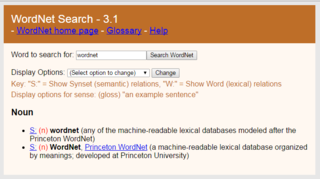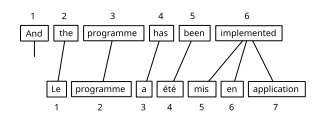Related Research Articles

A semantic network, or frame network is a knowledge base that represents semantic relations between concepts in a network. This is often used as a form of knowledge representation. It is a directed or undirected graph consisting of vertices, which represent concepts, and edges, which represent semantic relations between concepts, mapping or connecting semantic fields. A semantic network may be instantiated as, for example, a graph database or a concept map. Typical standardized semantic networks are expressed as semantic triples.

WordNet is a lexical database of semantic relations between words that links words into semantic relations including synonyms, hyponyms, and meronyms. The synonyms are grouped into synsets with short definitions and usage examples. It can thus be seen as a combination and extension of a dictionary and thesaurus. While it is accessible to human users via a web browser, its primary use is in automatic text analysis and artificial intelligence applications. It was first created in the English language and the English WordNet database and software tools have been released under a BSD style license and are freely available for download from that WordNet website. There are now WordNets in more than 200 languages.
Word-sense disambiguation (WSD) is the process of identifying which sense of a word is meant in a sentence or other segment of context. In human language processing and cognition, it is usually subconscious/automatic but can often come to conscious attention when ambiguity impairs clarity of communication, given the pervasive polysemy in natural language. In computational linguistics, it is an open problem that affects other computer-related writing, such as discourse, improving relevance of search engines, anaphora resolution, coherence, and inference.
Parsing, syntax analysis, or syntactic analysis is the process of analyzing a string of symbols, either in natural language, computer languages or data structures, conforming to the rules of a formal grammar. The term parsing comes from Latin pars (orationis), meaning part.
Semantic similarity is a metric defined over a set of documents or terms, where the idea of distance between items is based on the likeness of their meaning or semantic content as opposed to lexicographical similarity. These are mathematical tools used to estimate the strength of the semantic relationship between units of language, concepts or instances, through a numerical description obtained according to the comparison of information supporting their meaning or describing their nature. The term semantic similarity is often confused with semantic relatedness. Semantic relatedness includes any relation between two terms, while semantic similarity only includes "is a" relations. For example, "car" is similar to "bus", but is also related to "road" and "driving".
In linguistics, a word sense is one of the meanings of a word. For example, a dictionary may have over 50 different senses of the word "play", each of these having a different meaning based on the context of the word's usage in a sentence, as follows:
We went to see the playRomeo and Juliet at the theater.
The coach devised a great play that put the visiting team on the defensive.
The children went out to play in the park.

Grammar induction is the process in machine learning of learning a formal grammar from a set of observations, thus constructing a model which accounts for the characteristics of the observed objects. More generally, grammatical inference is that branch of machine learning where the instance space consists of discrete combinatorial objects such as strings, trees and graphs.

Bitext word alignment or simply word alignment is the natural language processing task of identifying translation relationships among the words in a bitext, resulting in a bipartite graph between the two sides of the bitext, with an arc between two words if and only if they are translations of one another. Word alignment is typically done after sentence alignment has already identified pairs of sentences that are translations of one another.
The sequence between semantic related ordered words is classified as a lexical chain. A lexical chain is a sequence of related words in writing, spanning narrow or wide context window. A lexical chain is independent of the grammatical structure of the text and in effect it is a list of words that captures a portion of the cohesive structure of the text. A lexical chain can provide a context for the resolution of an ambiguous term and enable disambiguation of concepts that the term represents.
In linguistics, statistical semantics applies the methods of statistics to the problem of determining the meaning of words or phrases, ideally through unsupervised learning, to a degree of precision at least sufficient for the purpose of information retrieval.

Distributional semantics is a research area that develops and studies theories and methods for quantifying and categorizing semantic similarities between linguistic items based on their distributional properties in large samples of language data. The basic idea of distributional semantics can be summed up in the so-called distributional hypothesis: linguistic items with similar distributions have similar meanings.

Ontology learning is the automatic or semi-automatic creation of ontologies, including extracting the corresponding domain's terms and the relationships between the concepts that these terms represent from a corpus of natural language text, and encoding them with an ontology language for easy retrieval. As building ontologies manually is extremely labor-intensive and time-consuming, there is great motivation to automate the process.
The Lesk algorithm is a classical algorithm for word sense disambiguation introduced by Michael E. Lesk in 1986.
Lexical substitution is the task of identifying a substitute for a word in the context of a clause. For instance, given the following text: "After the match, replace any remaining fluid deficit to prevent chronic dehydration throughout the tournament", a substitute of game might be given.
SemEval is an ongoing series of evaluations of computational semantic analysis systems; it evolved from the Senseval word sense evaluation series. The evaluations are intended to explore the nature of meaning in language. While meaning is intuitive to humans, transferring those intuitions to computational analysis has proved elusive.

BabelNet is a multilingual lexicalized semantic network and ontology developed at the NLP group of the Sapienza University of Rome. BabelNet was automatically created by linking Wikipedia to the most popular computational lexicon of the English language, WordNet. The integration is done using an automatic mapping and by filling in lexical gaps in resource-poor languages by using statistical machine translation. The result is an encyclopedic dictionary that provides concepts and named entities lexicalized in many languages and connected with large amounts of semantic relations. Additional lexicalizations and definitions are added by linking to free-license wordnets, OmegaWiki, the English Wiktionary, Wikidata, FrameNet, VerbNet and others. Similarly to WordNet, BabelNet groups words in different languages into sets of synonyms, called Babel synsets. For each Babel synset, BabelNet provides short definitions in many languages harvested from both WordNet and Wikipedia.
The following outline is provided as an overview of and topical guide to natural-language processing:

Babelfy is a software algorithm for the disambiguation of text written in any language.

In natural language processing (NLP), a word embedding is a representation of a word. The embedding is used in text analysis. Typically, the representation is a real-valued vector that encodes the meaning of the word in such a way that words that are closer in the vector space are expected to be similar in meaning. Word embeddings can be obtained using language modeling and feature learning techniques, where words or phrases from the vocabulary are mapped to vectors of real numbers.

Word2vec is a technique for natural language processing (NLP) published in 2013. The word2vec algorithm uses a neural network model to learn word associations from a large corpus of text. Once trained, such a model can detect synonymous words or suggest additional words for a partial sentence. As the name implies, word2vec represents each distinct word with a particular list of numbers called a vector. The vectors are chosen carefully such that they capture the semantic and syntactic qualities of words; as such, a simple mathematical function can indicate the level of semantic similarity between the words represented by those vectors.
References
- ↑ Navigli, R. (2009). "Word Sense Disambiguation: A Survey" (PDF). ACM Computing Surveys. 41 (2): 1–69. doi:10.1145/1459352.1459355. S2CID 461624.
- ↑ Nasiruddin, M. (2013). A State of the Art of Word Sense Induction: A Way Towards Word Sense Disambiguation for Under-Resourced Languages (PDF). TALN-RÉCITAL 2013. Les Sables d'Olonne, France. pp. 192–205.
- ↑ Van de Cruys, T. (2010). "Mining for Meaning. The Extraction of Lexico-Semantic Knowledge from Text" (PDF).
- ↑ Schütze, H. (1998). Dimensions of meaning. 1992 ACM/IEEE Conference on Supercomputing. Los Alamitos, CA: IEEE Computer Society Press. pp. 787–796. doi:10.1109/SUPERC.1992.236684.
- ↑ Lin, D. (1998). Automatic retrieval and clustering of similar words (PDF). 17th International Conference on Computational linguistics (COLING). Montreal, Canada. pp. 768–774.
- ↑ Van de Cruys, Tim; Apidianaki, Marianna (2011). "Latent Semantic Word Sense Induction and Disambiguation" (PDF).
- ↑ Lin, D.; Pantel, P. (2002). Discovering word senses from text. 8th International Conference on Knowledge Discovery and Data Mining (KDD). Edmonton, Canada. pp. 613–619. CiteSeerX 10.1.1.12.6771 .
- ↑ Widdows, D.; Dorow, B. (2002). A graph model for unsupervised lexical acquisition (PDF). 19th International Conference on Computational Linguistics (COLING). Taipei, Taiwan. pp. 1–7.
- 1 2 Véronis, J. (2004). "Hyperlex: Lexical cartography for information retrieval" (PDF). Computer Speech and Language. 18 (3): 223–252. CiteSeerX 10.1.1.66.6499 . doi:10.1016/j.csl.2004.05.002.
- ↑ Agirre, E.; Martinez, D.; De Lacalle, O. Lopez; Soroa, A. Two graph-based algorithms for state-of-the-art WSD (PDF). 2006 Conference on Empirical Methods in Natural Language Processing (EMNLP). Sydney, Australia. pp. 585–593.
- ↑ Di Marco, A.; Navigli, R. (2013). "Clustering and Diversifying Web Search Results with Graph-Based Word Sense Induction" (PDF). Computational Linguistics. 39 (3): 709–754. doi:10.1162/coli_a_00148. S2CID 1775181.
- ↑ Biemann, C. (2006). "Chinese Whispers - an Efficient Graph Clustering Algorithm and its Application to Natural Language Processing Problems" (PDF).
- ↑ Navigli, R.; Crisafulli, G. Inducing Word Senses to Improve Web Search Result Clustering (PDF). 2010 Conference on Empirical Methods in Natural Language Processing (EMNLP 2010). Massachusetts, USA: MIT Stata Center. pp. 116–126.
- ↑ Nasiruddin, M.; Schwab, D.; Tchechmedjiev, A.; Sérasset, G.; Blanchon, H. Induction de sens pour enrichir des ressources lexicales (Word Sense Induction for the Enrichment of Lexical Resources) (PDF). 21ème conférence sur le Traitement Automatique des Langues Naturelles (TALN 2014). Marseille, France. pp. 598–603.